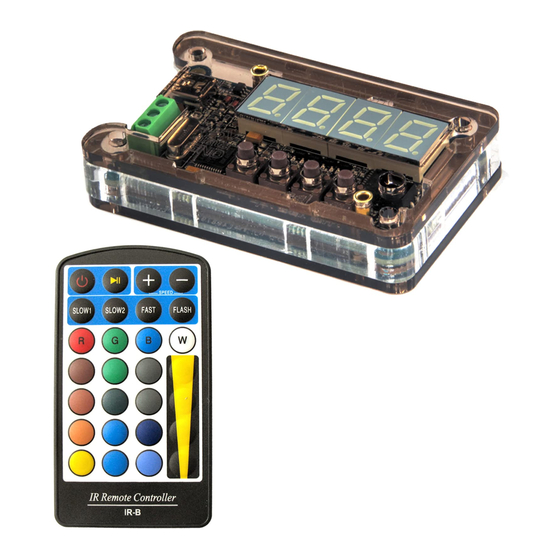DIAMEX WS2812 Manual - Page 6
Browse online or download pdf Manual for Controller DIAMEX WS2812. DIAMEX WS2812 10 pages.

DIAMEX LED CONTROLLER-L (Rev. 2)
Effect controller and TPM2 player for LED stripes with remote control
TPM2 PLAYER ABOUT USB
TPM is the abbreviation for "Transport Protocol for Matrices", a popular data protocol for the control
of LED stripes and panels. Several freely available programs now support this protocol, e.g. JINX or
GLEDIATOR. The data transfer from the PC to the LED player takes place via the USB interface at
maximum speed, so that a rate of 25 frames per second can be achieved and a flicker-free output is
guaranteed. A virtual COM port is usually set up via USB for the control, the COM port number of the
LED controller L2 can be determined via the Windows device manager and must be set in the play
program.
The play programs cannot read out the number of LEDs connected to the LED controller L2 and
therefore always output the data set in the program (corresponds to the number of LEDs in the
matrix * 3) via the TPM2 data. If this quantity is too large for the number of LEDs set at the LED
controller L2, the excess data is simply ignored. If the amount of data is too low, LEDs at the end of
the connected strip may remain dark.
When the LED controller L2 has received valid TPM2 data via the USB interface, it
automatically switches to the USB mode (also from the OFF mode) and outputs the
received data to the light-emitting diodes. 2 seconds after the end of data
transmission, the LED controller L2 automatically returns to the last mode
INTEGRATED EFFECTS
The LED controller-L2 has many factory-integrated static and dynamic effects optimized for the
connection of LED stripes. Static effects always affect the entire length of the connected strip.
However, many dynamic effects output their data in so-called segments, these are areas on the
stripe in which the effects are repeated. The length of these segments can be configured in the LED
Controller L2 setting menu.
The brightness of all effects as well as the playback speed of many dynamic effects can be changed at
any time by pressing the buttons or remote control.
The random mode plays the effects randomly and changes to the next effect after a set time. The
setting menu can be used to select whether only static, dynamic or all effects should be selected by
chance.
The type and number of built-in effects can vary from version to version of the LED controller-L2 bios
and are therefore not described in detail in this manual. Just try the effects.
OPERATION
The LED controller-L2 is operated via the 4 buttons on the device
or alternatively via the infrared remote control. The functions of
the (OFF) (SEL) (+) (-) buttons on the unit correspond largely to
the upper 4 buttons on the remote control (Pause) (+) (-).
To avoid unwanted calls to some functions, they can only be called up by pressing the keys for a long
time. These are found in the description of the key functions of the various function modes.
The function menu and all option menus are automatically exited when no button has been pressed
for 30 seconds on the unit or on the remote control. All menus are exited immediately with the OFF
button; any settings made are stored in the EEPROM of the LED controller-L2.
